The Durable Goods, advance report shows new orders increased by 3.5% for November 2013 after a -0.7% decrease in October. The really good news in this report is the growth in core capital goods. New orders in core capital goods increased 4.5% for November This report is often revised dramatically, yet even inventories did not decline. Even without volatile aircraft durable goods new orders increased.
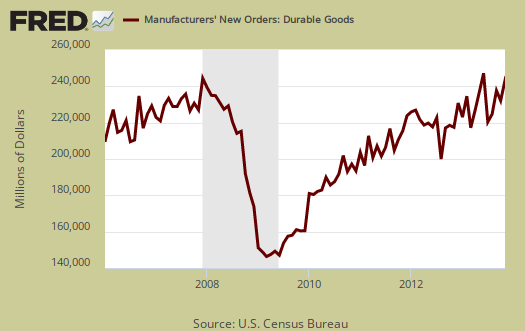
Below is a graph of all transportation equipment new orders, which soared by 8.4% for the month. Motor vehicles & parts actually increased by 3.3%. Aircraft and parts new orders from the non-defense sector increased 21.8%. Aircraft & parts from the defense sector increased by10.1%. Aircraft orders are notoriously volatile, each order is worth millions if not billions, and as a result aircraft manufacturing can skew durable goods new orders on a monthly comparison basis.

Core capital goods new orders shot up by 4.5% after declines for the previous two months. This implies a quickening of economic activity. Core capital goods is an investment gauge for the bet the private sector is placing on America's future economic growth and excludes aircraft & parts and defense capital goods. Capital goods are things like machinery for factories, measurement equipment, truck fleets, computers and so on. Capital goods are basically the investment types of products one needs to run a business. and often big ticket items. A decline in new orders indicates businesses are not reinvesting in themselves. Machinery by itself showed a 3.8% increase and communications equipment new orders shot way up by 13.0%.

To put the monthly percentage change in perspective, below is the graph of core capital goods new orders, monthly percentage change going back to 2000. Looks like noise right? We use so many graphs to amplify trends for one month of data does not an economy make, so be aware month to month changes can be very misleading.
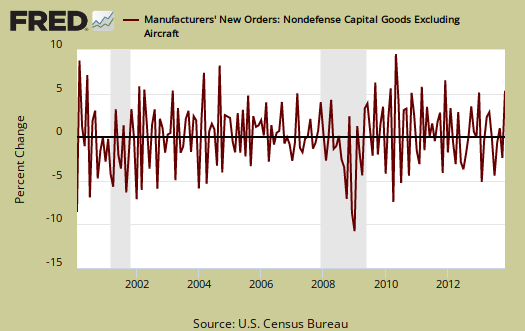
Shipments overall increased 1.8% and bear in mind new orders are not necessarily shipped the next month an order is made. Below is the monthly shipments; percent change for all durable goods shipments.

Shipments in core capital goods increased 2.8%.. The below graph goes back to 1990 to show how core capital goods shipments tracks recessions, the gray bars in the graph. This is yet another very good indicator something might be finally changing in the economy, a glimmer of sustained hope.
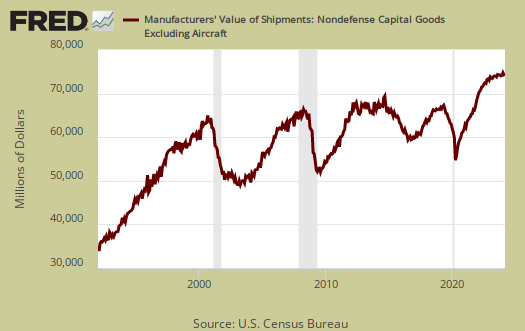
Inventories, which also contributes to GDP, increased 0.3%, the same as last month. Growth in inventories was 40% of Q3 GDP, of which durable goods inventories are a part, so seeing growth instead of contraction is surprising. Graphed below are total durable goods inventories monthly figures.
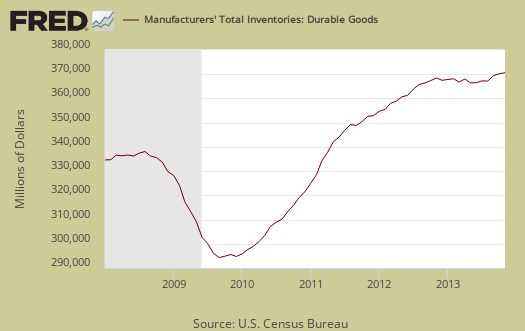
Core Capital Goods inventories had no change for the month. Graphed below are monthly core capital goods inventories annualized percentage change and pay close attention to the months of Q3, against the last two months. We do not have enough data to estimate changes in inventories, yet the below implies we will not see the corresponding cliff dive to Q3's build up, at least from durable goods core inventories.
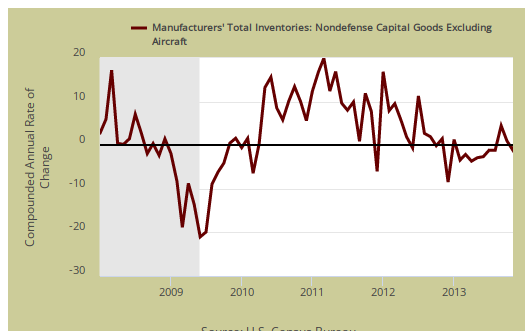
Core shipments contributes to the investment component of GDP. Producer's Durable Equipment (PDE) is part of the GDP investment metric, the I in GDP or nonresidential fixed investment. It is not all, but part of the total investment categories for GDP, usually contributing about 50% to the total investment metric (except recently where inventories have been the dominant factor). Producer's Durable Equipment (PDE) is about 75%, or 3/4th of the durable goods core capital goods shipments, in real dollars, used as an approximation. Below is the national accounts description of PDE:
Nonresidential PDE consists of private business purchases on capital account of new machinery, equipment such as furniture, and vehicles (except for personal-use portions of equipment purchased for both business and personal use, which are included in PCE), dealers' margins on sales of used equipment, and net purchases of used equipment from government agencies, from persons, and from the rest of the world.
The below graph might give a feel for what kind of investment component we might see shaping up for PDE and it's lookin' good for November. Note the below is the annualized monthly percentage change of nominal values, not real, not adjusted for inflation, for core capital goods shipments.

The report excludes semiconductor manufacturing and we must wonder if that means it is non-existent since so much has been offshore outsourced and thus corporations don't want the public to figure that fact out.
What is a durable good? It's stuff manufactured that's supposed to last at least 3 years. Here are our durable goods, related overviews, only some graphs revised. The durable goods advance report is often revised when the full factory orders statistics are released.

inventories not excessive
both shipments and unfilled orders are growing at a faster rate than inventories...
http://research.stlouisfed.org/fred2/graph/?graph_id=153037&category_id=0
rjs
sales/inventory ratios
bear this out as well, still such a large increase in Q3, what goes up usually goes down.
Retail sales look like they won't be good for Dec. from Xmas sales reports.
Holiday sales up 2.3% vs. 0.7% from last year
So much for early reports of mass consumerism holiday sales claiming they tanked. Mastercard just reported sales were up 2.3% vs. 0.7% from last years gain. I'll go with the original point we're going to see a very strong PCE for Q4.
better than a fourspot looks likely
i figured that even if December PCE was flat, (ie, goods sales down 0.2%, services up 0.1), PCE would still be up at a 3.8% annual rate in the 4th quarter...
even though some are marking up their 4th quarter estimates, most are still expecting a weak 4th quarter, mostly on inventories; i dont see it, and i havent seen a negative report yet; most are slightly positive, like the increase in durables inventores you cover here..
rjs